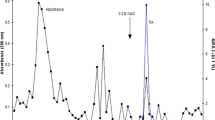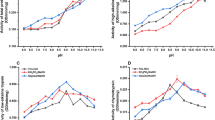Abstract
Helicoverpa armigera is the most devastating pest of important crops causing heavy yield losses. The larval midgut harbours proteases and their inhibition starves insects to death or may disrupt their normal metabolism. So there is need to characterize gut protease and its potential inhibitors. A serine protease (trypsin like) from H. armigera gut was purified ~37 folds with 22 % yield and its molecular weight was found to be ~18.8 kilo Dalton. The Michaelis constant using N-α-benzoyl-DL-arginine-p-nitroanilide as a substrate was 0.31 mM. Maximum reaction rate was determined to be 3.47 nmol p-nitroaniline/min. Free energy of binding was found to be −20.8 kJ/mol. The optimum temperature of enzyme was found to be 50 °C and around 17 % activity was maintained on heating at 80 °C for 30 min. The optimum pH for trypsin like activity was 11 with wide range of activity between 9 and 12 indicating that midgut digestive trypsin of H. armigera is active over wide range of alkaline pH. Metal ions Cu2+, Zn2+, Cd2+ and Hg2+ were found to have the potential to inhibit the enzyme. Maximum inhibition was observed with Cu2+ (73 %) and minimum inhibition with Cd2+ (47 %). Copper inhibited trypsin non-competitively and zinc inhibited uncompetitively. Ascorbic acid, EDTA, leupeptin and benzamidine were found to be competitive inhibitors of H. armigera gut protease. The Ki values for Cu2+, ascorbic acid, EDTA, leupeptin and benzamidine were found to be 1.32, 38.23, 2.51 mM, 37.13 µM and 5.66 mM respectively.






Similar content being viewed by others
References
Bhavani P, Bhattacharjee C, Prasad DT (2007) Bioevaluation of subabul (Leucaena leucocepahala) proteinases inhibitors on Helicoverpa armigera. Arthropod-Plant Interact 1:255–261
Wondafrash M, Getu E, Terefe G (2012) Life cycle parameters of African bollworm, Helicoverpa armigera (Hubner) (Lepidoptera: Noctuidae) affected by Neem, Azadirachta indica (A.Juss) extracts. Agric Sci Res J 2:335–345
Parde VD, Sharma HC, Kachole MS (2012) Protease inhibitors in wild relatives of pigeonpea against the cotton bollworm/legume pod borer, Helicoverpa armigera. Am J Plant Sci 3:627–635
Srinivasan A, Giri AP, Gupta VS (2006) Structural and functional diversities in Lepidopteran serine proteases. Cell Mol Biol Lett 11:132–154
Patankar AG, Giri AP, Harsulkar AM, Sainani MN, Deshpande VV, Ranjekar PK, Gupta VS (2001) Complexity in specificities and expression of Helicoverpa armigera gut proteases explains polyphagous nature of the insect pest. Insect Biochem Mol Biol 31:453–464
Özgür E, Yücel M, Öktem HA (2009) Identification and characterization of hydrolytic enzymes from the midgut of the cotton bollworm, Helicoverpa armigera Hübner (Lepidoptera: noctuidae). Turk J Agric For 33:285–294
Parde VD, Sharma HC, Kachole MS (2011) Inhibition of Helicoverpa armigera gut pro-proteinase activation in response to synthetic protease inhibitors. Entomol Exp Appl 142:104–113
Lowry OH, Roserbrough NJ, Farr AL, Randall RJ (1951) Protein measurement with Folin phenol reagent. J Biol Chem 193:256–275
Laemmli UK (1970) Cleavage of structural proteins during the assembly of the head of bacteriophage T4. Nature 227:680–685
Dixon M (1953) The determination of enzyme inhibitor constants. Biochem J 55:170–171
Huang M, Ye Y, Han Y (2014) Purification of a trypsin-like enzyme and cloning of its gene from Chinese ground beetle (Eupolyphaga sinensis). J Food Biochem 38:316–327
Oliveira MGA, De Simone SG, Xavier LP, Guedes NC (2005) Partial purification and characterization of digestive trypsin-like proteases from the velvet bean caterpillar, Anticarsia gemmatalis. Comp Biochem Physiol Part B 140:369–380
Hau PV, Benjakul S (2006) Purification and characterization of trypsin from pyloric caeca of bigeye snapper (Pricanthus macracanthus). J Food Biochem 30:478–495
Pereira ME, Dörr FA, Lima-Garcia JF, Peixoto NC, Brito GG (2005) Perspectives of digestive pest control with proteinase inhibitors that mainly affect the trypsin-like activity of Anticarsia gemmatalis Hübner (lepidoptera: noctuidae). Braz J Med Biol Res 38:1633–1641
Ranjbar M, Zibaee A, Sendi JJ (2014) A trypsin-like proteinase in the midgut of Ectomyelois ceratoniae Zeller (Lepidoptera: Pyralidae): purification, characterization, and host plant inhibitors. Arch Insect Biochem Physiol 85:1–12
Zeng F, Zhu Y, Cohen A (2002) Partial characterization of trypsin-like protease and molecular cloning of a trypsin-like precursor cDNA in salivary glands of Lygus lineolaris. Comp Biochem Physiol Part B 131:453–463
Purcell JP, Greenplate JT, Sammons RD (1992) Examination of midgut luminal proteinase activities in six economically important insects. Insect Biochem Mol Biol 22:41–47
Terra WR, Ferreira C (1994) Insect digestive enzymes: properties, compartmentalization and function. Comp Biochem Physiol Part B 109:1–62
Costa HMS, Junior ACVF, Amaral IPG, Hirata IY, Paiva PMG Jr, Carvalho LB, Oliveira V, Bezerra RS (2013) Metal-sensitive and thermostable trypsin from the crevalle jack (Caranx hippos) pyloric caeca: purification and characterization. Chem Central J 7:166. doi:10.1186/1752-153X-7-166
Huber R, Kukla D, Bode W, Schwager P, Bartels K, Deisenhofer J, Steigemann W (1974) Structure of the complex formed by bovine trypsin and bovine pancreatic trypsin inhibitor. II. Crystallographic refinement at 1.9 Å resolution. J Mol Biol 89:73–80
Briand L, Chobert JM, Tauzin J, Declerck N, Léonil J, Mollé D, Tran V, Haertlé T (1997) Regulation of trypsin activity by Cu2+ chelation of the substrate binding site. Protein Eng 10:551–560
Willett WS, Brinen LS, Fletterick RJ, Craik CS (1996) Delocalizing trypsin specificity with metal activation. Biochem 35:5992–5998
Castañeda-Agullo M, Castilló LMD, Whitaker JR, Tappel AL (1961) Effect of ionic strength on the kinetics of trypsin and alpha chymotrypsin. J Gen Physiol 44:1103–1120
Klomklao S, Benjakul S, Visessanguan W (2004) Comparative studies on proteolytic activity of spleen extracts from three tuna species commonly used in Thailand. J Food Biochem 28:355–372
Kurinov IV, Harrison RW (1996) Two crystal structure of the leupeptin—trypsin complex. Protein Sci 5:752–758
Zhu YC, Baker JE (1999) Characterization of midgut trypsin-like enzymes and three Trypsinogen cDNAs from the lesser grain borer, Rhyzopertha dominica (Coleoptera: Bostrichidae). Insect Biochem Mol Biol 29:1053–1063
Dabrowski K, Köck G (2014) The effect of ascorbate on proteolytic enzyme activities in fish. Int J Vitam Nutr Res 59:157–160
Goodling RH, Cheung AC, Rolseth BM (1973) The digestive processes of haematophagous insects: III. Inhibition of trypsin by honey and the possible functions of the Oesophageal diverticula of mosquitoes (diptera). Can Entomol 105:433–436
Mares-Guia M, Rogana E, Amorin AF, Magalha˜es-Rocha NM (1981) Kinetic evidence for a two-state hybrid model for the trypsin activation by modifiers. J Biol Chem 256:1661–1668
Acknowledgments
The authors are thankful to Pulses section of Department of Plant Breeding and Genetics, Punjab Agricultural University, Ludhiana for providing the research material.
Author information
Authors and Affiliations
Corresponding author
Ethics declarations
Conflict of interest
The authors declare that they have no conflict of interest.
Rights and permissions
About this article
Cite this article
Grover, S., Kaur, S., Gupta, A.K. et al. Characterization of Trypsin Like Protease from Helicoverpa armigera (Hubner) and Its Potential Inhibitors. Proc. Natl. Acad. Sci., India, Sect. B Biol. Sci. 88, 49–56 (2018). https://doi.org/10.1007/s40011-016-0732-0
Received:
Revised:
Accepted:
Published:
Issue Date:
DOI: https://doi.org/10.1007/s40011-016-0732-0




